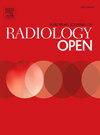应用加多西酸增强MRI和IVIM预测肝切除术后肝癌早期复发
IF 2.9
Q3 RADIOLOGY, NUCLEAR MEDICINE & MEDICAL IMAGING
引用次数: 0
摘要
本研究旨在开发和验证肝细胞癌(HCC)早期复发的预测图,利用加多etic酸增强MRI和体素内非相干运动(IVIM)成像来改善术前评估和决策。材料与方法2018年3月至2022年6月,回顾性纳入两家医院共245例病理证实的HCC患者,术前行加多西酸增强MRI和IVIM检查。这些患者被分为训练组(n = 160)和验证组(n = 85)。所有患者均被随访至死亡或最后一次随访日,随访期至少为2年。比较训练组和验证组的临床指标和病理信息。在训练队列中,采用卡方检验、Mann-Whitney U检验和独立样本t检验比较复发组和非复发组的放射学特征和扩散参数。进行单因素和多因素分析,以确定与培训队列中早期复发相关的重要临床放射学变量。基于这些发现,建立了一个综合危险因素和扩散参数的预测nomogram。在训练组和验证组中对nomogram预测性能进行了评估。结果训练组和验证组的临床和病理特征无统计学差异。在训练队列中,复发组和非复发组在肿瘤大小、结节内结构、马赛克结构、肿瘤边缘不光滑、肿瘤内坏死、卫星结节和肝胆期肿瘤周围低强度(HBP)方面存在显著差异。多因素分析结果确定肿瘤大小(HR, 1.435;95 % ci, 0.702-2.026;p <; 0.05),马赛克建筑(HR, 0.790;95 % ci, 0.421-1.480;p <; 0.05),非光滑肿瘤边缘(HR, 1.775;95 % ci, 0.941-3.273;p <; 0.05),肿瘤内坏死(HR, 1.414;95 % ci, 0.807-2.476;p <; 0.05),卫星结节(HR, 0.648;95 % ci, 0.352-1.191;p <; 0.01),肿瘤周围低强度对HBP的影响(HR, 2.786;95 % ci, 1.141-6.802;p <; 0.001)和D (HR, 0.658;95 % CI, 0.487 - -0.889;P <; 0.01)为复发的独立危险因素。在训练组和验证组中,nomogram C-index分别为0.913和0.875,具有较好的预测效果。同时,根据nomogram评分对患者进行危险因素分类,Kaplan-Meier曲线分析也显示nomogram具有较好的预测效果。结论综合放射危险因素和扩散参数的nomogram影像学图可为HCC患者早期复发的术前预测提供可靠的工具。本文章由计算机程序翻译,如有差异,请以英文原文为准。
Prediction early recurrence of hepatocellular carcinoma after hepatectomy using gadoxetic acid-enhanced MRI and IVIM
Objectives
This study aims to develop and validate a predictive nomogram for early recurrence in hepatocellular carcinoma (HCC), utilizing gadoxetic acid-enhanced MRI and intravoxel incoherent motion (IVIM) imaging to improve preoperative assessment and decision-making.
Materials and methods
From March 2018 and June 2022, a total of 245 patients with pathologically confirmed HCC, who underwent preoperative gadoxetic acid-enhanced MRI and IVIM, were retrospectively enrolled from two hospitals. These patients were divided into a training cohort (n = 160) and a validation cohort (n = 85). All patients were followed until death or the last follow-up date, with a minimum follow-up period of two years. Clinical indicators and pathologic information were compared between train cohort and validation cohort. Radiological features and diffusion parameters were compared between recurrence and non-recurrence groups using the chi-square test, Mann-Whitney U test and independent sample t test in training cohort. Univariate and multivariate analyses were performed to identify significant clinical-radiological variables associated with early recurrence in the training cohort. Based on these findings, a predictive nomogram integrating risk factors and diffusion parameters was developed. The predictive performance of the nomogram was evaluated in both the training and validation cohorts.
Results
No statistically significant difference in clinical and pathologic characteristics were observed between the training and validation cohorts. In training cohort, significant differences were identified between the recurrence and non-recurrence groups in tumor size, nodule-in-nodule architecture, mosaic architecture, non-smooth tumor margin, intratumor necrosis, satellite nodule, and peritumoral hypo-intensity in the hepatobiliary phase (HBP). The results of multivariate analysis identified tumor size (HR, 1.435; 95 % CI, 0.702–2.026; p < 0.05), mosaic architecture (HR, 0.790; 95 % CI, 0.421–1.480; p < 0.05), non-smooth tumor margin (HR, 1.775; 95 % CI, 0.941–3.273; p < 0.05), intratumor necrosis (HR, 1.414; 95 % CI, 0.807–2.476; p < 0.05), satellite nodule (HR, 0.648; 95 % CI, 0.352–1.191; p < 0.01), peritumoral hypo-intensity on HBP (HR, 2.786; 95 % CI, 1.141–6.802; p < 0.001) and D (HR, 0.658; 95 % CI,0.487–0.889; p < 0.01) were the independent risk factor for recurrence. The nomogram exhibited excellent predictive performance with C-index of 0.913 and 0.875 in the training cohort and validation cohort, respectively. Also, based on the nomogram score, the patients were classified according to risk factor and the Kaplan-Meier curve analysis also showed that the nomogram had a good predictive efficacy.
Conclusion
The nomogram, integrating radiological risk factors and diffusion parameters, offers a reliable tool for preoperative prediction of early recurrence in HCC patients.
求助全文
通过发布文献求助,成功后即可免费获取论文全文。
去求助
来源期刊

European Journal of Radiology Open
Medicine-Radiology, Nuclear Medicine and Imaging
CiteScore
4.10
自引率
5.00%
发文量
55
审稿时长
51 days
 求助内容:
求助内容: 应助结果提醒方式:
应助结果提醒方式:


